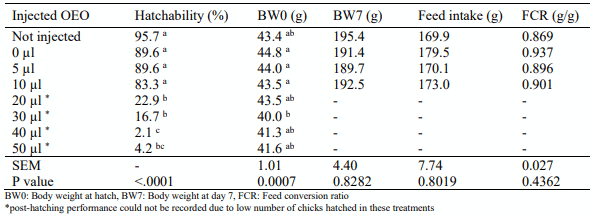In-Ovo Injection of Oregano Essential Oil up to 10µl Showed No Impact on Embryo Survivability in Broiler Chickens
Published: March 13, 2024
By: S. NIKNAFS 1, M.M.Y. MEIJER 1, A.A. KHASKHELI 1 and E. ROURA 1 / 1 Queensland Alliance for Agriculture and Food Innovation (QAAFI), The University of Queensland, Australia.
Oregano essential oil (OEO) and carvacrol, the main compound of OEO, are considered as a reference for biological activities of essential oils (EO). OEO has positive effects on gut and immune system developments potentially related to antimicrobial and antioxidant activities in chickens (Brenes and Roura, 2010). Embryonic development accounts for one-third of the lifespan of modern broiler chickens, and has the potential to determine performance in later life. In-ovo injection is a powerful tool for delivering biologically active compounds such as EOs. However, little is known about the safety margins of injection of EOs on hatchability regarding the injected concentration and volume. The objective of this study was to identify the maximum safe concentration of OEO that can be administered to broiler chickens during embryonic development.
A dose response of OEO including 0 (injected control), 5, 10, 20, 30, 40, or 50µl of oil emusified using 1:1 polysorbate 80 into 1000µl physiological saline solution were injected into the amnion of 48 eggs (each treatment) at day 17.5 of incubation. A non-injected control group was also included. Hatchability and post-hatching performance until day 7 were measured.
Results showed that in-ovo injection of OEO at levels above 10µl dramatically reduced hatchability (P < 0.01; Table 1). The OEO injection up to 10µl showed no significant (P > 0.05) impacts on hatchability, growth, and feed intake until day 7. These results are in contrast with toxicity thresholds published in rats showing a safety margin of oral administration of OEO up to 200mg/kg body weight (Llana-Ruiz-Cabello et al, 2017). Thus, this study showed that chicken embryos are remarkably more sensitive to toxicity of OEO compared to rats.
In conclusion, in-ovo injection of OEO up to 10µl did not have any significant effect on hatchability and post-hatching performance. Impact of non-toxic levels of OEO on embryonic development and particularly gut functionality and the immune system warrant further invistigation.
Table 1 - Effects of in-ovo injection of different amounts of oregano essential oil (OEO) on hatchability and performance parameters up to 7 days post-hatching. OEO was injected into the amnion of fertile eggs at day 17.5 of incubation (n = 48 per treatment).

ACKNOWLEDGEMENTS: This work was partially funded by AgriFutures Australia and Delacon Biotechnik GmbH.
Presented at the 34th Annual Australian Poultry Science Symposium 2023. For information on the next edition, click here.
Brenes A & Roura E (2010) Anim. Feed Sci. Tech. 158: 1-14.
Llana-Ruiz-Cabello M, Maisanaba S, Puerto M, Pichardo S, Jos A, Moyano R & Cameán AM (2017) Food Chem. Toxi. 101: 36-47.
Content from the event:
Related topics:
Authors:



Recommend
Comment
Share

Would you like to discuss another topic? Create a new post to engage with experts in the community.







